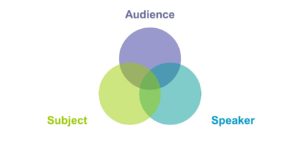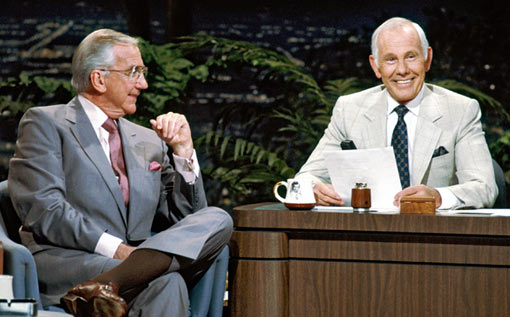“H-e-r-e-‘s Johnny!” Ed McMahon’s introduction of Johnny Carson on the Tonight Show was probably the shortest but one of the most famous introductions in entertainment.
Usually, introductions need to be a little longer. Introductions fuse 3 elements: the subject, the audience and the speaker.

The introduction brings together those elements and serves as a bridge, a transition from one part of the meeting to another. The audience may have just listened to a speaker on a totally different subject or may be mulling over a conversation they just had. An introduction gives the audience time to make a mental and emotional shift. A well-written and well-delivered introduction prepares people for the speaker, heightening their sense of anticipation. All too often a speaker introduction focuses too much on the speaker, listing out credentials and accolades . . . B-O-R-I-N-G.
Here’s one format you can try:
1. Audience-focused opening which shows the benefit, or why the audience should listen. –Ask questions (Do you want to . . .?) or make statements (If you want to . . .). The questions or statements should speak to a need/pain that the audience has. Follow the questions or statements with your main thesis (what the presentation is about).
2. Name and relevant credentials. You don’t have to list everything. Write out your name phonetically if it is even a tiny bit difficult.
3. Humorous anecdote: optional, but memorable (should be very brief)
4. Takeaways preview. Whet their appetite by telling them, briefly what they can expect to get out of the presentation.
5. Title of presentation
As an example, here’s a sample introduction for my presentation on Strategic Storytelling in Business:
Audience-focused opening
If you want to reduce your anxiety when you speak to a group . . .
If you want people to remember your message . . .
If you want to build trust . . . then, you need to use storytelling in
your business!
Name and relevant credentials
Our presenter, Diane Windingland (Win-deen-land), is the author of Small Talk Big Results: Chit Chat Your Way to Success! and the coauthor of Perfect Phrases for Icebreakers.
Diane speaks for organizations that want their people to have
better, more profitable conversations.
Humorous anecdote
Diane started out many years ago as an engineer with awkward
conversation skills. Through life experiences, owning a few businesses, networking,
Toastmasters and improv classes she has come a long way from
the young woman who would duck into the restroom to avoid
talking with people.
Now, she follows people into the restroom, just to talk to them!
Well . . . just women. 🙂
Take-aways preview
Today, Diane will help you discover the power of storytelling in
business, learn some techniques for crafting compelling stories,
and begin to tell your own stories!
Title of presentation
Please join me in welcoming Diane as she presents, “Strategic
Storytelling for Business.”
You should send your introducer your introduction in advance, but don’t assume the introducer will bring it, so bring a copy. Make sure that it is at least a 14 point font, with lots of white space and not longer than one page. Also don’t assume that the introducer has read it. Before you speak, review the pronunciation of your name and anything else that might trip the tongue. If it is important that your introduction is read exactly as you wrote it, tell the introducer that.
Remember it’s not all about you! It’s about you, your subject and your audience. Create a more audience-focused introduction.


2 Responses